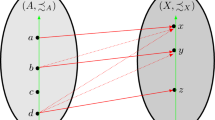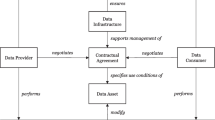Abstract
The paper presents a logic-based framework for modeling the interaction among peers. It is assumed that each peer consists of a database, a set of standard logic rules, a set of mapping rules allowing to import a maximal set of atoms not leading to inconsistency and a set of integrity constraints. The proposal relies on previous works in Calvanese et al. (in: PODS, 2004) and Caroprese et al. (in: FLAIRS, 2006) where a (declarative) semantics for P2P systems is defined. Under this semantics, only facts not making the local databases inconsistent can be imported—Weak Models. This mechanism leads to the concept of Maximal Weak Models that are weak models in which peers import maximal sets of facts not violating integrity constraints. Different extensions to the basic framework, that aim at introducing significant mechanisms of preferences among different scenarios in the case of conflicting information, can be provided. This paper presents the basic framework of Maximal Weak Models and two extensions: the Trusted Weak Model Semantics and the Dynamic Weak Model Semantics. The Trusted Weak Model Semantics stems from the observation that the framework proposed in Calvanese et al. (in: PODS, 2004) and Caroprese et al. (in: FLAIRS, 2006) does not provide any mechanism to set priorities among mapping rules, rules that “integrate” data of a source peer into the database of a target peer. Anyhow, while collecting data, it is quite natural for a source peer to associate different degrees of reliability to the portion of data provided by its neighbor peers. Therefore, this paper enhances the basic semantics by using priority levels among mapping rules in order to select the weak models containing a maximum number of mapping atoms according to their importance. We will call these weak models, Trusted Weak Models, and we will show they can be computed as stable models of a logic program with weak constraints. The Dynamic Weak Model Semantics further enhances the basic framework by introducing aggregates and different levels of preference criteria that are not rigid, i.e., fixed a priori at design time, but depends on the database instance. The extended framework allows to model concepts like “in the case of conflicting information, it is preferable to import data from the neighbor peer that can provide the maximum number of tuples” or “in the case of conflicting information, it is preferable to import data from the neighbor peer such that the sum of the values of an attribute is minimum” without selecting a priori preferred peers. We will call these weak models, Dynamic Weak Models, and we will show they can be computed as stable models of a logic program with a list of sets of priorities.
Similar content being viewed by others
Notes
The special syntax used for a fact—its first part is the peer identifier—will be formally presented in Sect. 3.
The precise syntax and semantics of mapping rules will be formally defined in Sect. 3.
We use for the operator and both ‘, ’ and ‘\(\wedge \).’
Higher values for priority levels mark weak constraints of higher importance.
A program with a weak constraint \(\Leftarrow p(X)\) can be regarded as modeling a minimization problem whose objective function is the cardinality of p.
Whenever the reference to a peer predicate (resp. peer atom, peer literal, peer fact, peer rule, peer standard rule, peer integrity constraint, peer mapping rule ) is clear from the context, the term peer can be omitted.
A built-in atom is of the form \(\theta (X,Y)\), where X and Y are terms and \(\theta \in \{<,>,\le ,\ge ,=,\ne \}\). It is also denoted as \(X\ \theta \ Y\).
In fact, under stable model semantics a strong constraint of the form \(\leftarrow {\mathscr {B}}\) is actually a shorthand for \(p \leftarrow {\mathscr {B}}, \lnot p\).
References
Abiteboul S, Hull R, Vianu V (1995) Foundations of databases. Addison-Wesley, Boston
Arenas M, Bertossi L, Chomicki J (1999) Consistent query answers in inconsistent databases. In: PODS, pp 68–79
Bertossi L, Bravo L (2004) Query answering in peer-to-peer data exchange systems. In: Extending database technology workshops
Bertossi L, Bravo L (2007) The semantics of consistency and trust in peer data exchange systems. In: LPAR, pp 107–122
Bertossi L, Bravo L (2017) Consistency and trust in peer data exchange systems. TPLP 17(2):148–204
Bikakis A, Antoniou G (2008) Distributed defeasible contextual reasoning in ambient computing. In: European conference on ambient intelligence. Springer, Berlin, pp 308–325.
Brewka G, Eiter T (1999) Preferred answer sets for extended logic programs. Artif Intell 109(1–2):297–356
Brewka G, Eiter T (2007) Equilibria in heterogeneous nonmonotonic multi-context systems. In: AAAI, pp 385–390
Brewka G, Niemela I, Truszczynski M (2003) Answer set optimization. In: IJCAI, pp 867–872
Brewka G (2002) Logic programming with ordered disjunction. In: AAAI/IAAI, pp 100–105
Brewka G, Niemela I, Truszczynski M (2003) Answer set optimization. In: IJCAI
Buccafurri F, Leone N, Rullo P (2000) Enhancing disjunctive datalog by constraints. TKDE 12(5):845–860
Calvanese D, De Giacomo G, Lembo D, Lenzerini M, Rosati R (2007) Inconsistency tolerance in P2P data integration: an epistemic logic approach. In: International Workshop on Database Programming Languages. Springer, Berlin, pp 90-105.
Calvanese D, De Giacomo G, Lenzerini M, Rosati R (2004) Logical foundations of peer-to-peer data integration. In: PODS, pp 241–251
Caroprese L, Greco S, Zumpano E (2006) A logic programming approach to querying and integrating P2P deductive databases. In: FLAIRS, pp 31–36
Caroprese L, Molinaro C, Zumpano E (2006) Integrating and querying P2P deductive databases. In: IDEAS, pp 285–290
Caroprese L, Zumpano E (2007) Consistent data integration in P2P deductive. In: SUM, pp 230–243
Caroprese L, Zumpano E (2008) Modeling cooperation in P2P data management systems. In: ISMIS, pp 225–235
Caroprese L, Zumpano E (2012) Handling preferences in P2P systems. In: FOIKS, pp 91–106
Caroprese L, Zumpano E (2017) P2P Deductive databases: well founded semantics and distributed computation. In: ADBIS, pp 91–99
Caroprese L, Zumpano E. P2P deductive databases: a system prototype. In: iiWAS 2017, pp 258–265
Caroprese L, Zumpano E (2000) A logic framework for P2P deductive databases. Theory Pract Log Program 20(1):1–43
Delgrande JP, Schaub T, Tompits H (2000) Logic programs with compiled preferences. In: ECAI, pp 464–468
Delgrande JP, Schaub T, Tompits H (2003) A framework for compiling preferences in logic programs. TPLP 3(2):129–187
Franconi E, Kuper GM, Lopatenko A, Zaihrayeu I (2004) Queries and updates in the coDB peer to peer database system. In: VLDB, pp 1277–1280
Franconi E, Kuper GM, Lopatenko A, Zaihrayeu I (2003) A robust logical and computational characterisation of Peer-to-Peer database systems. In: DBISP2P, pp 64–76
Franconi E, Kuper GM, Lopatenko A, Zaihrayeu I (2004) A distributed algorithm for robust data sharing and updates in P2P database networks. In: EDBT Workshops, pp 446–455
Gelder AV (1989) The Alternating Fixpoint of Logic Programs with Negation. In: PODS, pp 1–10
Gelfond M, Lifschitz V (1988) The Stable Model Semantics for Logic Programming. In: ICLP/SLP, pp 1070–1080
Gelfond M, Son TC (1997) Reasoning with prioritized defaults. In: LPKR pp 164–223
Greco S (1999) Dynamic programming in datalog with aggregates. IEEE Trans. Knowl. Data Eng. 11(2):265–283
Greco S, Greco G, Zumpano E (2003) Repairing and querying inconsistent databases. TKDE 15(6):1389–1408
Halevy AY, Zachary GI, Suciu D, Tatarinov I (2003) Schema mediation in peer data management systems. In: ICDE, pp 505–516
Lenzerini M (2002) Data integration: a theoretical perspective. In: PODS, pp 233–246
Leone N, Pfeifer G, Faber W, Eiter T, Gottlob G, Perri S, Scarcello F (2006) The DLV system for knowledge representation and reasoning. ACM Trans. Comput. Log. 7(3):499–562
Lloyd JW (1987) Foundations of logic programming. Springer, Berlin
Lonc L, Truszczynski M (2000) On the Problem of Computing the Well-Founded Semantics. In: International conference on computational logic. Springer, Berlin, pp 673-687
Papadimitriou CH (1994) Computational complexity. Addison-Wesley, ISBN 978-0-201-53082-7, pp. I-XV, 1-523
Sakama C, Inoue K (2000) Prioritized logic programming and its application to commonsense reasoning. Artif Intell 123(1–2):185–222
Sakama C, Inoue K (1996) Representing priorities in logic programs. In: JICSLP, pp 82–96
Schaub T, Wang K (2001) A comparative study of logic programs with preference. In: IJCAI, pp 597–602
Syrjanen T, Niemela I (2001) The smodels system. In: LPNMR, pp 434–438
Wakaki T, Inoue K, Sakama C, Nitta K (2003) Computing preferred answer sets in answer set programming. In: LPAR conference, pp 259–273
Wang K, Zhou L, Lin F (2000) Alternating Fixpoint Theory for Logic Programs with Priority. In: International conference on computational logic. Springer, Berlin, pp 164-178.
Yang B, Garcia-Molina H (2003) Designing a super-peer network. In: ICDE
Zhang Y, Foo N (1997) Answer sets for prioritized logic programs. In: ILPS, pp 69–83
Author information
Authors and Affiliations
Corresponding author
Additional information
Publisher's Note
Springer Nature remains neutral with regard to jurisdictional claims in published maps and institutional affiliations.
Rights and permissions
About this article
Cite this article
Caroprese, L., Zumpano, E. Declarative Semantics for P2P Data Management System. J Data Semant 9, 101–122 (2020). https://doi.org/10.1007/s13740-020-00115-6
Received:
Revised:
Accepted:
Published:
Issue Date:
DOI: https://doi.org/10.1007/s13740-020-00115-6




